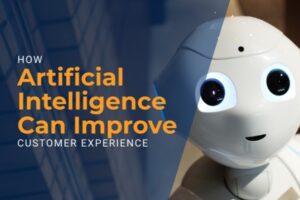With the advent of computers that started in the early 1900’s, thoughts quickly turned to speculation that a computer could someday match human intelligence. In 1950, Alan Turing devised the Turing Test that became a threshold for when a machine is said to become intelligent. The test uses a human evaluator that watches a conversation between two parties. The evaluator knows that one of the parties is a machine, and if the evaluator cannot distinguish between the human and the machine, the machine is said to be intelligent. While the notion of Artificial Intelligence can bring thoughts of computers someday becoming self-aware, we do not have to worry about that just yet. In our era, artificial intelligence (AI) has become an important tool that can be used in contact centers to become a performance differentiator.
Machine Learning is a branch of AI. It uses data to feed algorithms that will automatically learn and improve. Machine Learning falls into two broad categories: Supervised and Unsupervised. In supervised learning, the output datasets are provided and used to train the machine and get the desired outputs for future datasets. Unsupervised learning does not use output data, but instead the data is clustered into different classes and then analyzed.
Many industry verticals have become commoditized to the point where offerings are very similar or the same across the competitive market. This applies to BPOs as well as the companies that they provide contact center services for. In order to gain and keep market share, it has become essential to give a best in class customer experience. Machine Learning can help with this process.
Contact centers typically generate a multitude data. Data sources include systems with data for CRM, billing, collection, agent QA, call recording, chat, email, CSAT, social media, etc. All of this data tells a story about the customer and the contact center’s interaction with them.
The recent progress made in AI has come in parallel to similar progress made with voice recognition and natural language processing technology. It is now possible to convert real time conversations or voice recordings to text with a high degree of accuracy. Having a conversation in a text readable format gives the ability to mine the agent and customer conversation.
The easiest way to understand how data and machine learning can work together in concert, is to describe an example scenario. The process uses an archetype that can be applied generally to Supervised Machine Learning. Shown below on the left of the arrow is the generic process step and on the right, a specific example that uses a voice recording as the data source. It should be noted that the data source could come from any of the sources discussed above.
- Identify data source(s) à voice recording
- Generate learning data à convert the voice into text
- Machine learning analysis à process text data
- Machine learning correlation à correlate success and failure outcomes with patterns in the agent and customer conversation; find out how the best agents generate success; identify the criteria of the call that causes the call to be successful. The output of this step will produce actionable insights.
- Make improvement suggestions à use the insights from the previous step to make improvement recommendations. Improvements can come in many forms including agent training, agent and customer matching, providing real time customer data to the agent to be used during future sales opportunities, script changes and so on.
- Implement recommendations à take action by improving the script, training the agent and so on.
- Predict success à the learning used in machine learning is used to predict the likelihood of success. A benefit of predictability is that an action can be taken based on the predicted behavior.
- Feedback à verify that agents are using the training recommendations by running the process again iteratively to verify that they are contributing to attaining key success metrics. Feedback is also used in the success prediction.
Determining what successful agents say is the basis for building on that foundation and giving it to the agents that are not as successful. Once you know the why about success, you have taken the first step to answering the how about how to improve it. Positive customer experience plays directly into understanding the success equation. A customer that makes a purchase or gives a positive customer satisfaction rating for service that they received, will be identified by using the machine learning process.
Other data sources can be added into the model to improve the predictability quotient. CSAT could be used to help further identify success patterns. Another possibility is using customer attributes that can be obtained commercially. Commercial data includes purchase habits, household income, age, gender, home market value, occupation and many more. These data marts are a good way to give the agent more direct information about the customer. In addition, they are used to improve the accuracy of the predictive modeling. Customer attributes are used to enhance the customer experience and increase the likelihood of reaching success. Many attributes about the customer that are found using their phone number or email address can give further insights.
Using a computer generated call that speaks as if it was a human being brings this model full circle. Using the technology in this way has just come on the scene in the past couple of years. It still has a long way to go, because customers are able to tell that the caller is a computer talking to them rather than a person. In 1950, Alan Turing probably never envisioned that the Turing Test would be used with automated dialing systems. Using machine learning in conjunction with the mined voice text to learn from, with the advances in natural language constructs, brings new opportunities like was seen with assembly line automation in the early 20th Century. Calling and speaking using a computer will reduce staff and lead to labor cost savings. It should be noted that there are TCPA requirements, state and federal laws that should be thoroughly understood and must be followed before using this type of technology.
When we get to the point that a customer cannot tell that a machine called and is speaking to them, the Turing Test will pass and the machine will be considered intelligent. Once that happens, we may be closer than we would like to the day that computational awareness becomes a reality.
Bob Kasten is a partner at CH Consulting Group and the founder of contactcentertools.com. His tools provide a holistic suite of agent performance management modules that includes: KPI performance tracking dashboards, voice analytics, QA scoring, knowledge testing, goals, coaching and secure clean desk agent communication. He spends his time consulting on contact center information technology projects and enhancing his agent performance management tool. He can be reached for questions or comments at bob.kasten@contactcentertools.com or on LinkedIn at www.linkedin.com/in/bob-kasten/.




